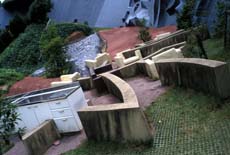index
Kant's argument for linkage
click on images for full-size:





The side of a house in Seaside, Florida

Perceiving the side of a different house (Site of Reversible Destiny, Arakawa and Gins, Yoro, Japan)

Perceiving objects by their possible uses

Perceiving objects by their possible uses (Site of Reversible Destiny, Arakawa and Gins, Yoro, Japan)
Kant argued that if there is to be experience at all, there must be conceptual norms and connections that link separate temporal and spatial moments together as more than a series of befores and afters. Experiencing a series of perceptions as a temporal series involves cross-time connections. Experiencing a sequence of perceptions as perceptions of a house involves concepts and models by which I can see that this current visual impression and that one five minutes ago, though separated in time, are impressions of neighboring sides of the house. A temporal sequence becomes a unified experience because beyond the one-after-another of sequence there are other categories and relations that define the unity of the experienced object and provide a point of unity for the experiencing subject. These allow us to make a distinction between the structure of what appears and the order of its appearings. The ability to do this for concrete objects also demands, Kant argues, more general syntheses according to categories and guidelines concerning causality, permanence in time, and the unity of the perceiving subject. These can apply to places as well.Later, phenomenologists made related claims that any present object gets its meaning from a norm-guided insertion within a horizon of connected but absent possibilities for past and future perceptions. Those possibilities, Heidegger argued, are not just sets of other perceptions; they include socially defined actions. This horizon of possibilities could involve our expectation that the chair facing us also has a back side, or the action possibilities that give practical point to a doorknob, or a pencil, or the wide range of possibilities that give meaning to a revolutionary social act. Those possibilities in turn get their meaning from their connections to still others in a net that has no definite boundaries. Because there must be such connections, no present moment or aspect stands isolated on its own. No spatial or temporal item can be revealed to us as meaningful unless it is immersed within a wider web that is present to us as absent possibilities governed at the center by practical and conceptual grammars, but leading off towards wilder possibilities as well.